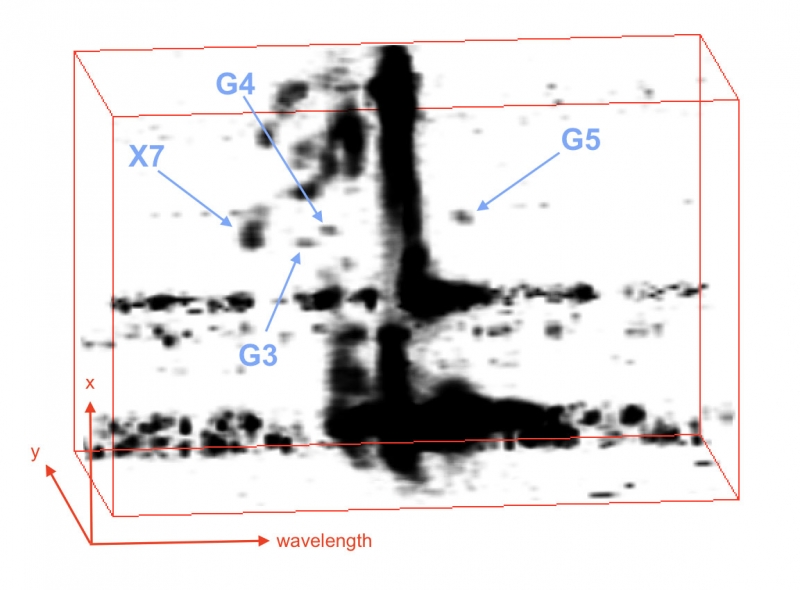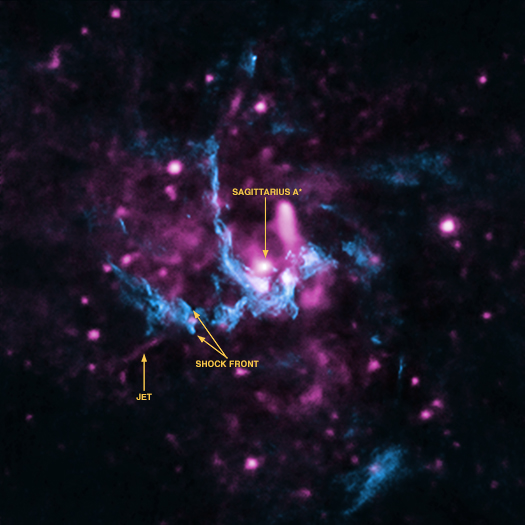
Astronomers said on June 6, 2018, that they analyzed 12 years of data gathered at the W. M. Keck Observatory in Hawaii to discover several more of the bizarre objects known as G-objects. Only two examples were previously known of these strange galactic inhabitants, which are located behind a shroud of galactic dust, near Sagittarius A* (pronounced Sagittarius A-star), the supermassive black hole at our Milky Way galaxy’s heart. Astronomers discovered the first G-object – G1 – in 2004 and the second – G2 – in 2012. Both were thought to be gas clouds until they made their closest approach to the black hole. Both G1 and G2 somehow managed to survive the hole’s gravitational pull, which wouldn’t have happened if they were gas clouds; a 4-million-solar-mass black hole like Sagittarius A* can shred gas clouds apart. Now these same astronomers report three more of the strange G-objects – which they’ve labeled G3, G4 and G5 – near the galaxy’s heart. The astronomers said they:
… look like gas clouds, but behave like stars.
Astronomer Anna Ciurlo – a member of the Galactic Center Orbits Initiative at UCLA – led a team that reached this conclusion. She announced the team’s result at the American Astronomical Society meeting going on this week in Denver, Colorado. Ciurlo said in a statement:
These compact dusty stellar objects move extremely fast and close to our galaxy’s supermassive black hole. It is fascinating to watch them move from year to year. How did they get there? And what will they become? They must have an interesting story to tell.
Randy Campbell is science operations lead at Keck Observatory. He developed software called OsrsVol, short for OSIRIS-Volume Display, resulting in a custom volume rendering tool that let the astronomers separate G3, G4, and G5 from the dusty background in the direction of the galaxy’s center. Once the 3-D analysis was performed, the team could clearly distinguish the G-objects, which allowed them to follow their movement and see how they behave around the supermassive black hole. Campbell explained:
We started this project thinking that if we looked carefully at the complicated structure of gas and dust near the supermassive black hole, we might detect some subtle changes to the shape and velocity. It was quite surprising to detect several objects that have very distinct movement and characteristics that place them in the G-object class, or dusty stellar objects.
Astronomer Mark Morris of UCLA added:
If they were gas clouds, G1 and G2 would not have been able to stay intact. Our view of the G-objects is that they are bloated stars – stars that have become so large that the tidal forces exerted by the central black hole can pull matter off of their stellar atmospheres when the stars get close enough, but have a stellar core with enough mass to remain intact. The question is then, why are they so large?

These astronomers pointed out that something must have caused these stars to swell up. It’s possible they’re the result of a collision between two stars orbiting each other. Collisions like this could happen near the galaxy’s center, as the gravity of the giant black hole exerts its influence on the surrounding space. Over a long period of time, the astronomers said, the black hole’s gravity alters the orbits of the two stars in a binary system until the duo collides. A G-object could be a combined object, resulting from this violent merger. Morris said:
In the aftermath of such a merger, the resulting single object would be puffed up, or distended, for a rather long period of time, perhaps a million years, before it settles down and appears like a normal-sized star.
So the G-objects may be showing us some of the strange scenarios taking place at our galaxy’s center, among objects orbiting near Sagittarius A*. And they’re showing us that these events are happening quickly, relative to a typical astronomical timescale. A million years, for example, is a blink on that timescale, and yet we now see five of these objects. How many more are there, still to be discovered?
The team said they’ll continue to follow the size and shape of the known G-objects’ orbits, which could provide important clues as to how they formed. They said they’ll be paying close attention when these dusty stellar compact objects make their closest approach to the supermassive black hole. And that’s the bad news for us humans, because – although the events at the galaxy’s center are happening quickly on an astronomical timescale – still, outer space doesn’t operate on anything like a convenient human timescale. This close encounter is expected to occur 20 years from now for G3, and longer for G4 and G5.
Yet we know astronomers will be watching, because, as their statement explained:
This will allow [us] to further observe their behavior and see whether the objects remain intact just as G1 and G2 did, or become a snack for the supermassive black hole. Only then will they give away their true nature.

Bottom line: Two previously known G-objects – G1 and G2 – came incredibly close to the Milky Way’s central black hole, yet survived. Now astronomers report 3 more of these mystery G-objects – which they’re calling G3, G4 and G5 – near the heart of our galaxy.
Help EarthSky keep going! Please donate what you can to our annual crowd-funding campaign.











